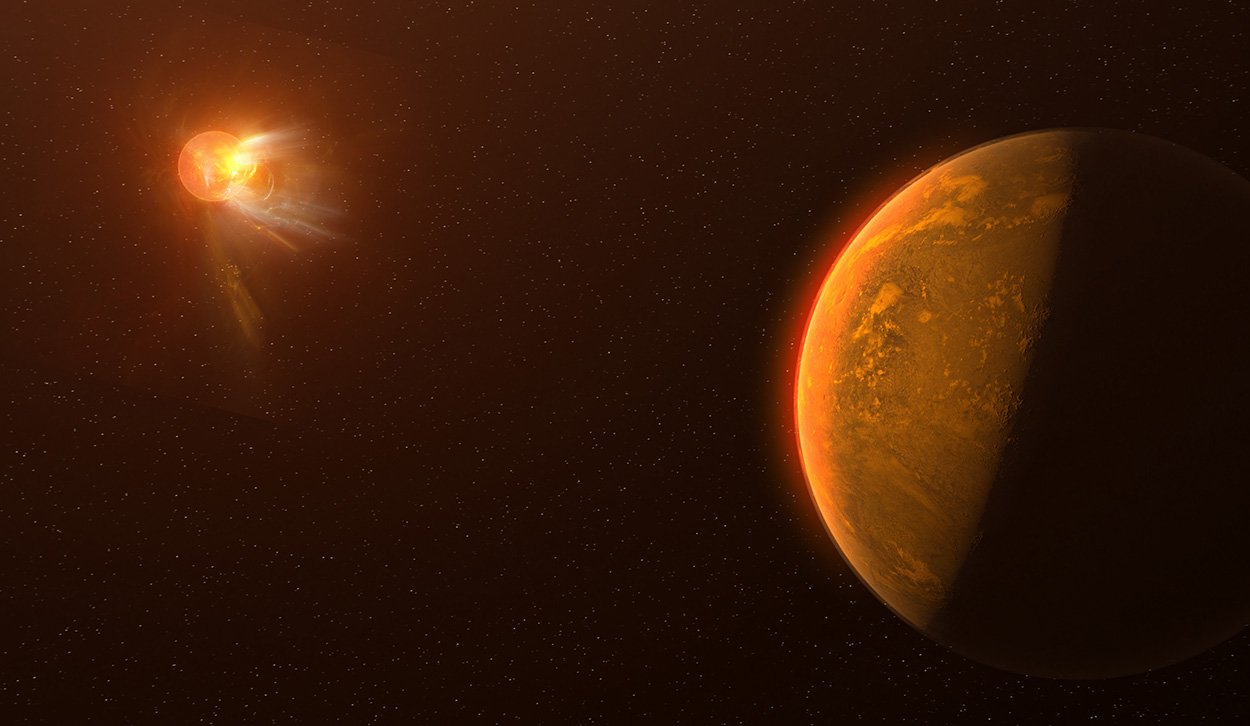The red dwarf star Proxima Centauri is our closest neighbor in space, so its two planets, which are only about four light-years away from us, could be the first targets of future interstellar space missions. But, as has now been confirmed, its star is not quiet: astronomers observed a massive explosion of radiation from Proxima Centauri in May 2019. It lasted only a few seconds, but released massive amounts of energy in the form of radiation. At the radio and millimeter range, this was the strongest explosion of this star ever detected. However, this is not good news for planets around Proxima Centauri.
The star Proxima Centauri is only about four light-years away. Accordingly, astronomers extensively searched for planets there – with success. It is now clear that our neighboring star has two planets. The exoplanet, Proxima Centauri c, is a super-Earth planet about seven times the mass of Earth, orbiting the star outside the habitable zone. This differs with Proxima Centauri b, the inner part of the two planets. It is roughly the size of Earth, orbits in the habitable zone of its star, and may also contain liquid water. In this respect, this Earth-like planet could be life-friendly. Proxima Centauri b is closer to its star than the Earth is to the Sun, but it is a red dwarf – a much smaller and cooler star than our Sun. Three-quarters of all stars in the Solar Quarter belong to this spectral type.
Astral eruption on all channels
The problem, however, is that many red dwarfs are very active and often generate powerful bursts of radiation. This releases bursts of high-energy radiation that could be life-killing to nearby planets. The atmosphere of such a planet could also be weakened or torn apart by radiation and particle storms over time. So astronomers have been debating for a long time whether life on exoplanets around red dwarfs could form or continue. This also applies to Proxima Centauri. It is known from our neighboring star that there are regular bursts of radiation on it – sometimes several times a day. “Proxima Centauri is as old as our Sun, so it has likely been hitting its planets with high-energy flares for billions of years,” explains co-author Alicia Weinberger of the Carnegie Institution for Science in Washington, DC.
Observations made by a team of astronomers led by Meredith MacGregor of the University of Colorado now show just how violent the radiation blows are at Proxima Centauri. Researchers targeted our neighboring star with nine ground-based telescopes stationed in orbit – including the Hubble and TESS space telescopes and the Atacama Large Millimeter Array (ALMA) radio antennas. In Spring and Summer 2019, they continue to point the optics of these telescopes to Proxima Centauri, hoping to be able to capture a glow for the first time using many different telescopes in parallel. On May 1, 2019, it was time: “The star suddenly became 14,000 times brighter in UV light,” according to McGregor. Even in the radio and millimeter wave range, the red dwarf’s brightness suddenly increased by a factor of a thousand. “In the past, we didn’t even know that stars also shine in the millimeter range when they erupt,” MacGregor explains. “This is the first time that we have observed a stellar explosion in such a large spectral range.”
what is the reason?
The full burst of radiation lasted less than ten seconds, but during this time it released large amounts of energy, especially in the ultraviolet and radio waves. “In the range of millimeters and ultraviolet rays distant from the spectrum, this is the strongest glow ever detected by Proxima Centauri,” according to the astronomers’ report. In contrast, telescopes recorded only a slight increase in brightness in the visible range of light, while TESS increased values by only about 0.9 percent. In addition, the pulse of radiation in visible light only reached its peak with a delay of one minute. “These traits were never noticed in such a dwarf star – this indicates that we are witnessing a whole new kind of event here,” writes MacGregor and her team. Star-ray bursts usually occur when magnetic field lines suddenly reconfigure themselves on the surface of a star. Also at Proxima Centauri, astronomers attribute the outbreak to the reconnection of magnetic field lines and the acceleration of electrons as a result. On the other hand, the light radiation emitted with a slight delay could be due to the heated plasma at the foot of the magnetic loops – this is the assumption.
But for the two planets around our neighboring star, such intense explosions of radiation are not good news. “If there is life on the inner planet of Proxima Centauri, it should look very different from anything we know about Earth,” MacGregor explains. “It would be a very bad thing for humans on this planet.” Additionally, such a violent radiation explosion recorded on May 1, 2019 is by no means rare on red dwarves like Proxima Centauri. “The planets around Proxima Centauri experience such flares not just once every century, but perhaps at least once a day, if not several times a day,” says MacGregor.
Coyle: Meredith McGregor (University of Colorado, Boulder) Date Al. The Astrophysical Journal Letters, Doi: 10.3847 / 2041-8213 / abf14c

“Alcohol buff. Troublemaker. Introvert. Student. Social media lover. Web ninja. Bacon fan. Reader.”






More Stories
Ecologists Celebrate New Xesap National Park in Laos | Science
Is the wrong diet making you forget?
We can study it with a new telescope.